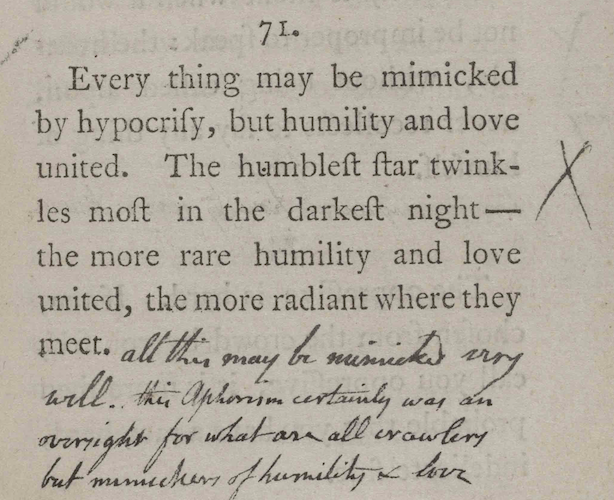Since I’ve just joined Team Marginalia, Laura said it might be useful for me to take a look at a few books and articles that discuss marginalia in general and Blake’s in particular. I’ve been browsing through them in the last couple of days and I thought others might find a few of their remarks about marginalia to be of interest. For instance, while Mark O’Connell’s article in the New Yorker (http://www.newyorker.com/books/page-turner/the-marginal-obsession-with-marginalia) considers the reader’s collaborative engagement with other readers a fundamental affordance of marginalia, he also emphasizes the intimate nature of marginalia as writing – the private, often perhaps emotional conversation between book and reader that it might be indecent to peep into. Jason Snart on the other hand views Blake’s marginalia as disruptive. The “mark” poses a challenge to the monolithic authority of the printed text, exposing its weakness and thereby opening it up for argument, discussion, appropriation and rejection (Jason Snart, The Torn Book 124). He focuses more on the competitive nature of marginalia rather than the qualities of affection and intimacy. Here are examples of cases where Blake agrees vehemently with the author and where he equally vehemently disagrees:


The mingling of marginalia and text poses numerous practical challenges for transcription, and some of the questions explicitly deal with whether the marginalia should be disentangled from the text, or whether “where one begins and the other ends” (Laura Estil, “Encoding the Edge: Marginalia and the TEI” https://journals.psu.edu/dls/article/view/59715/59912) remains open to discussion. Recent blogposts by Team Marginalia consider the different ways of approaching tricky situations, such as where Blake crosses out a printed word and replaces it with one of his own.
In fact, Blake (and others scribbling all over books) have more freedom to become enmeshed with the text than we at the Blake Archive do with our “comments,” which are designed for internal use and not meant for publication. First of all, it’s very difficult for them to mingle with the rest of the .xml file because they’re green, and enclosed by exclamation marks. You can see them coming a mile away. And while it is true that unlike Blake, who engages intimately with what he reads, we normally use the comments for more technical as well as collaborative purposes.


This leads me to wonder about the future of our own (green) marginalia. Team Color Code often discusses the specifics of citing Justin Van Kleeck’s comments, since they provide us with such a reliable guideline for transcription, but what about the more ephemeral ones? Will they survive in some form in the future, even after these works are published, and continue their friendly/frenzied interactions within the BADs (Blake Archive Document), or will they only last as long as it takes to solve the problems and then be forever consigned to oblivion?
